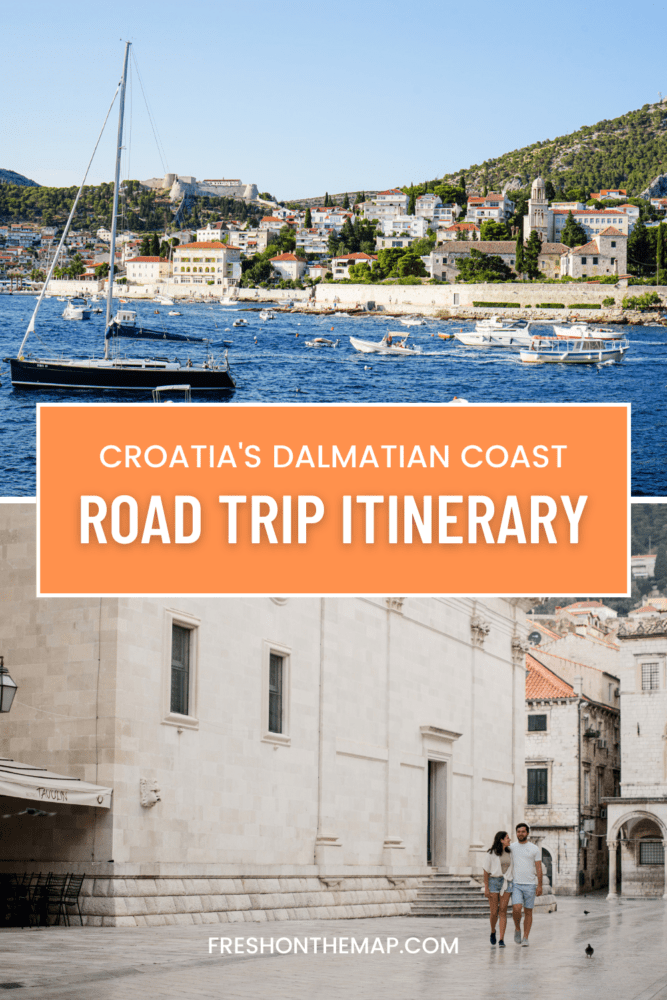Croatia Road Trip: 1 Week Itinerary on the Dalmatian Coast
After living in Serbia for 2 years, Croatia quickly became one of our favorite nearby travel destinations. It’s packed with incredible food and wine, historic cities, and a stunning coastline along the Adriatic Sea. One of the best ways to explore this country is by embarking on a Croatia road trip. The entire country is worth exploring, but the Dalmatian coast has a special place in our hearts. It’s where we celebrated our honeymoon and truly found it to be the perfect blend between architecture and nature.
In this blog post, we will guide you through a Croatia road trip down the Dalmatian coast, highlighting the best places to visit and sharing tips on making the most of your journey.
And if you’re looking for more, make sure to check out our post on 7 of the most beautiful places to visit in Croatia here.
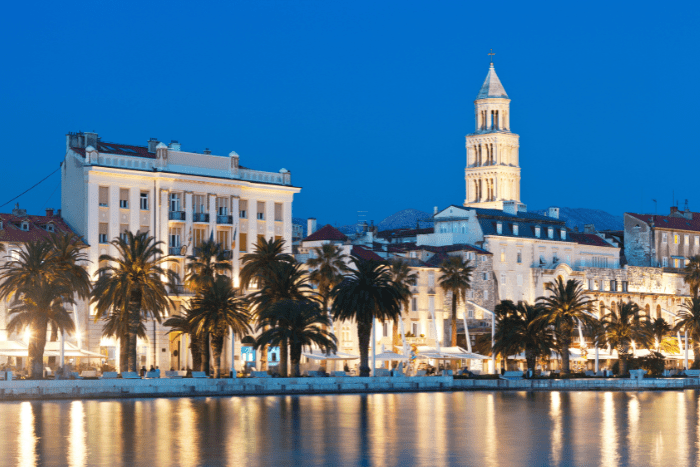
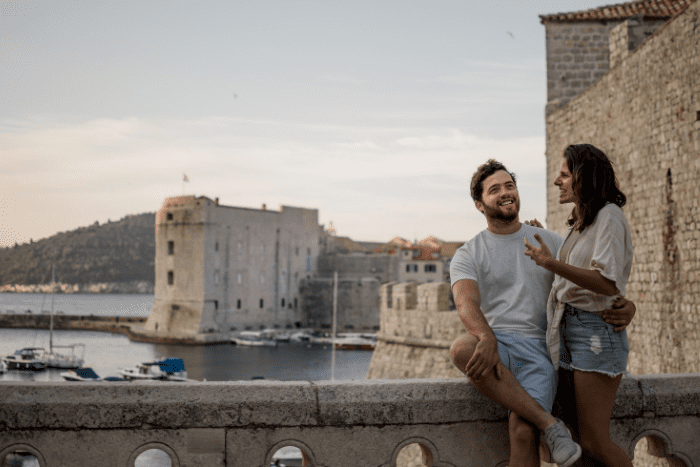
Rental Car Options
If you want to embark on this Croatia road trip, you can fly into Split or Dubrovnik. They are both major airports with a wide range of destinations. To mirror our trip, we will be heading south on the coast, so starting in Split and ending in Dubrovnik. However, you could easily swap routes, depending on your travel arrangements.
With the popularity of Game of Thrones, and thus of Croatia, the country has invested significantly in its tourism industry. As a result, you’ll find that roads are generally in good condition. Some of them can be a bit narrow and windy, but for the most part, you should not have a lot of trouble driving.
For car rentals, we recommend using Discover Cars. The site is very user-friendly and aggregates all types of vehicles and prices to make sure you find the best deal. Their customer service is also quite helpful if you ever run into an issue or need to alter a reservation.
Best Time to Visit Croatia
We love visiting places in the off-season. In the case of Croatia, this is between October and April. While the weather can be a bit cold at times, it’s the perfect time to enjoy the bigger cities like Dubrovnik without the packed crowds. However, avoid visiting the islands during these months since restaurants and hotels will be closed for the season.
June, July, and August are the peak summer seasons. This means the weather is hot and perfect for the beach. It also means prices will be at the highest point and crowds will be everywhere, but if you’re looking for your dream beach vacation, this is the best time for this Croatia road trip.
If you’re hoping for a quieter experience and are willing to compromise on more unpredictable weather, we would highly recommend visiting during the months of May or September. This is the so-called “shoulder season” when things are still largely open. The ocean might be a bit cooler, but crowds are much smaller are prices lower.
Tips to Keep in Mind
Croatia is a very welcoming and easy-to-visit place. People are friendly and generally speak English, and for the most part, streets and accommodations are safe and easy to maneuver. However, there are a few tips that will be helpful to keep in mind as you plan your Croatia road trip.
- Make reservations in advance. Regardless of the season, but especially if you’re traveling in the summer, we highly recommend making reservations for hotels, restaurants, and wineries in advance. They fill up quickly and if you wait to make them until you arrive, you might be too late. If you don’t have a reservation, it’s best to arrive at the restaurant early. For instance, if they open at 6pm for dinner, make sure to arrive right at 6pm. You’ll have a much higher chance of being seated.
- Arrive early for ferries. If you’re bringing your car on the ferry, you should arrive there at least 1 hour in advance. The problem is that while you can purchase a ticket for your vehicle, you’re not guaranteed a space during a particular time. This means that if 50 cars fit in the ferry, for example, only the first 50 in line will be allowed to travel. The others will need to wait for the next boat. This happened to us on the ferry to Hvar and it was a pretty frustrating experience. Jadrolinija is a large national carrier and we recommend purchasing all tickets online in advance.
- Wake up early to avoid crowds. Cities like Split and Dubrovnik have become quite popular, and as a result, quite crowded, especially in the peak seasons. If you’re able to, we highly recommend choosing at least one day to wake up early (by 6am) to explore the city on your own. It’s truly a memorable experience since it’ll give you a real sense of the city and leave you with much nicer photos.
- Bring water shoes. We’ve made this mistake more times than we’re willing to admit, but most of these beaches have pebbles or rocks rather than sand, making it incredibly painful if you’re walking barefoot. While it’s doable, the experience will certainly be better if you bring along some nice water shoes.
Croatia Road Trip Itinerary
Day 1-2: Split


Split is a charming city, known for its rich history, cultural heritage, and stunning natural beauty, making it the perfect spot to start our Croatia road trip. It’s incredibly unique because a big piece of the city was built around the remains of Roman ruins and the Diocletian Palace. This means that throughout the city, you’ll continue to see a special blend of historical ruins right next to modern shops and delicious restaurants. It’s also the main gateway to nearby islands (more on that below).
Where to Stay
- Hotel Vestibul Palace & Villa (luxury, boutique hotel in the heart of Diocletian’s Palace)
- Hotel Slavia (stunning hotel in the historic city center)
- Hotel Peristil (used to be a part of Diocletian’s Palace, 200 meters away from Riva)
- Backpackers Fairytale (affordable hostel, just 3 minutes away from the city center)
- Hotel Park (right next to Bačvice beach, with an outdoor pool and nice restaurant)
- Radisson Blu Resort & Spa (a bit outside the city center, but with the perfect resort feel)
- Luxury Apartment Mirage Split (nice apartment in the Varoš neighborhood)
What to Do
- Explore Diocletian’s Palace bright and early. This is the best preserved Roman palace today. It is no longer a palace, but the city’s center, where you can still catch glimpses of the original columns and arches. It can get very crowded, so we highly recommend exploring very early so you can get a real sense of the magic behind these alleyways.
- Bask in the sunshine at Bačvice Beach. The water is crystal clear and the beach is very accessible from Split, but for that reason, it can also get quite crowded. There are areas with chairs and umbrellas to rent as well. If you need a break from the sun, head up to Cafe Bar Zbirac for a drink on their lovely terrace.
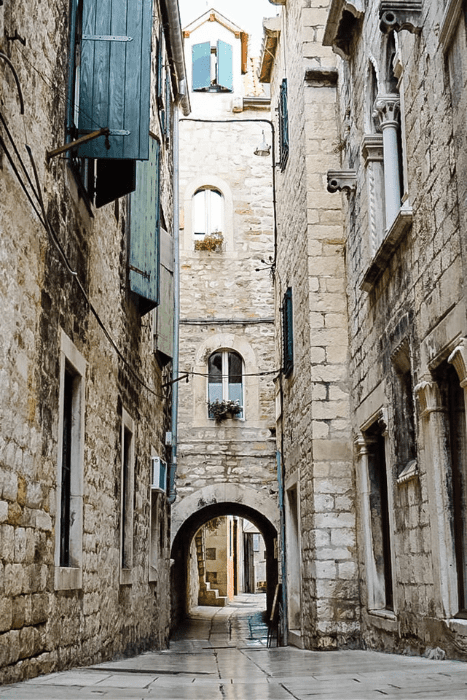
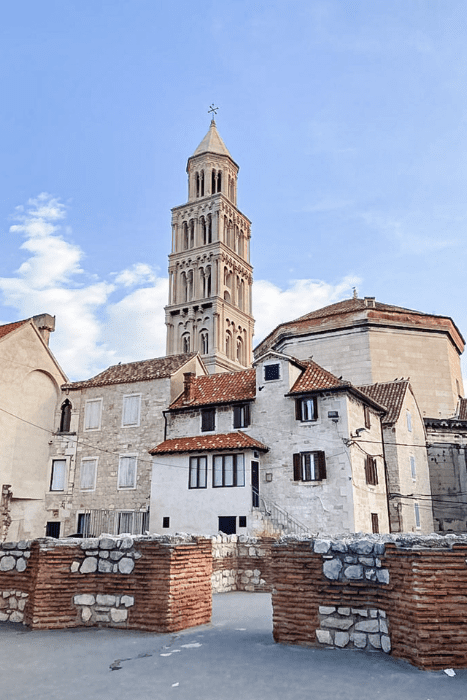
- Climb up Marjan Hill. It’s about a 15-minute walk from Diocletian Palace and not too challenging, but the views of the city will make it absolutely worth it. You can grab a drink at Vidilica Cafe or keep heading up to explore more historical buildings.
- Walk over to the Varoš neighborhood. This is a cute neighborhood, about a 20-minute walk away from the Diocletian Palace. It’s one of the oldest in Split and since it’s a bit outside of the city, it’s the perfect place to escape the crowds. It’s also home to Obojena Beach, which we actually preferred over Bačvice. Just note that there are no umbrellas, so come prepared.
- Grab a drink on the Riva waterfront. This is Split’s famous waterfront, and it’s packed with small cafes and the perfect place to just grab a drink, relax, and people-watch.
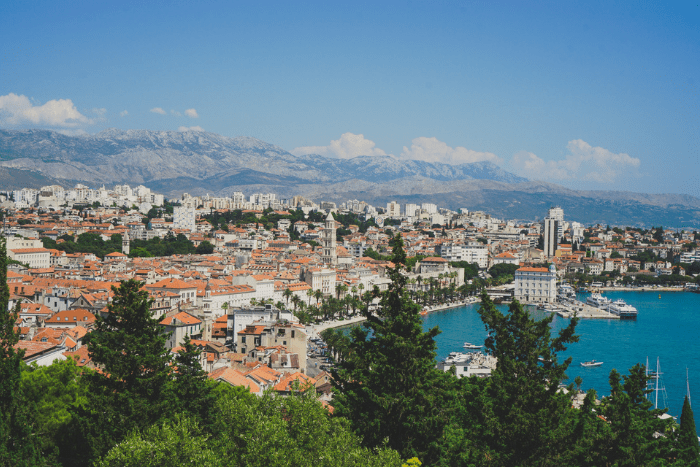
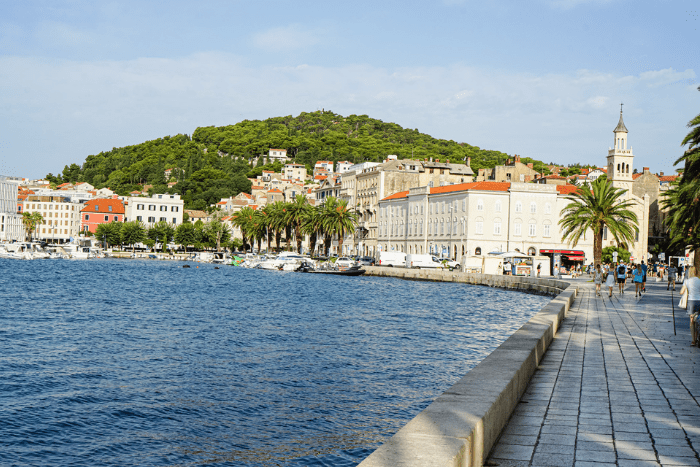
Where to Eat & Drink
- Uje Oil Bar (deliciously simple food with very kind staff)
- Restaurant Dvor (beautiful terrace and unique plates)
- Mazzgoon (delicious seafood and a lovely terrace in the back of the restaurant)
- Articok (wonderful dishes with a beautiful outdoor rooftop terrace)
- Pandora GreenBox (delicious vegetarian food)
- Ćiri Biri Bela (delicious brunch and lovely outdoor terrace)
- Kat’s Kitchen Deli (nice brunch in Varoš, worth the wait)
- Villa Spiza (yummy traditional street food)
- Vidilica Cafe (incredible views of Split)
- Monika’s Wine Cellar (great selection of local wines)
- Cafe Bar Zbirac (super cool day bar, just above Bačvice Beach)
- D16 Coffee (very popular for its cold brew)
- Oš Kolač (gorgeous cakes)
- Luka Ice Cream & Cakes (best gelato in Split)
Day 3-4: Hvar
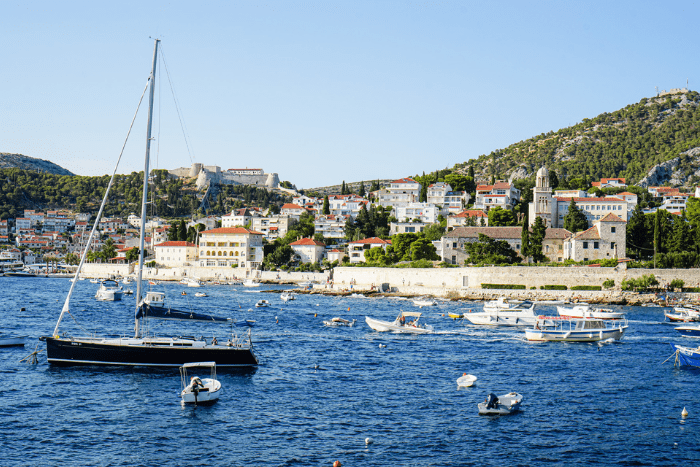
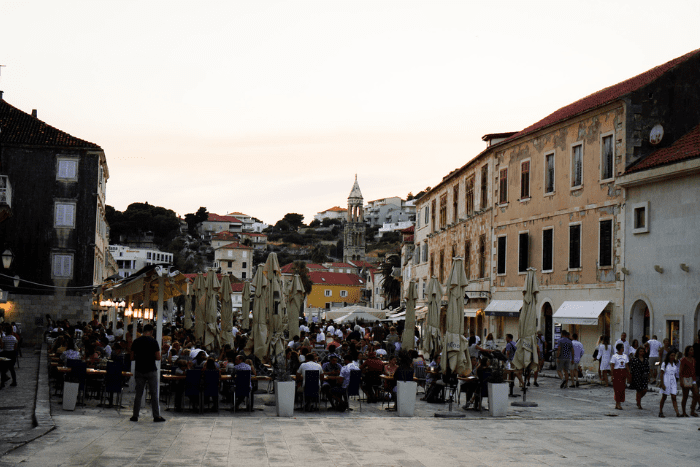
Croatia has over 40 inhabited islands, so the choice of which one to visit is certainly not easy. We chose to continue our Croatia road trip with the island of Hvar. It came highly recommended by our friends in Belgrade, not only for its beautiful beaches but also for its high-quality wine and olive oil, widely regarded as some of the best in the region.
We were looking for an island big enough for us to bring our car and be able to drive around and explore, but one that also had small unique pockets within. Hvar was the perfect place for this. We loved getting to drive around the island, but also greatly enjoyed being able to hike along the coast or through abandoned villages.
To get here, we took the ferry from Split to Hvar, which was a couple of hours. Note that there are a number of ports in Hvar. If you have a car, you’ll want to take the ferry from Split to Stari Grad, in the northern part of the island.
Where to Stay
- Hotel Fortuna (cute hotel, right on the beach in the Milna village)
- Hotel Moeesy, Blue & Green Oasis (brand new property, on the beach and close to the center)
- B&B Buzolic (nice apartments, just 10 minutes away from the center)
- Holiday Home Rudina (peaceful and secluded home in the north part of the island)
- Villa Tamara (apartment in Zavala, with a beautiful terrace overlooking the ocean)
- Plage Cachée (beautiful glamping property, with a large property and incredible views)
- Villa Ekatera (charming villa with a pool in Stari Grad)
What to Do
- Hike along the coast. You start in Pokonji Dol Beach, which gets quite crowded, so try to go early, but it does have some nice large rocks to lay on and soak in the sun. There are two restaurants there, but they are quite expensive. From there, keep walking to Mekićevica Beach. It’s a nice, but small cove, perfect for a quick dip to cool down. And lastly, keep going until you reach Robinson Cove. It’s a lot less crowded, with more space to relax, and a cute restaurant.
- Relax in Dubovica Beach. This is a lovely cove and one of our favorite beaches on the island. Make sure to go early because since you have to park on the side of the road, there really aren’t many parking spots available. From there, you’ll need to hike down about 10 minutes, but it’s incredibly worth it. We went at about 7am, so the water was certainly a bit chilly but it felt magical because it was entirely secluded.
- Take a road trip around the island. The best way to explore Hvar is with a car and you can easily bring yours along on the ferry. The southern side is home to some of the best beaches, but there is something to explore all around, including some beautiful olive fields on the way to Sućuraj. If you do make that drive, make sure to stop in one of the stands along the street for some delicious olive oil.
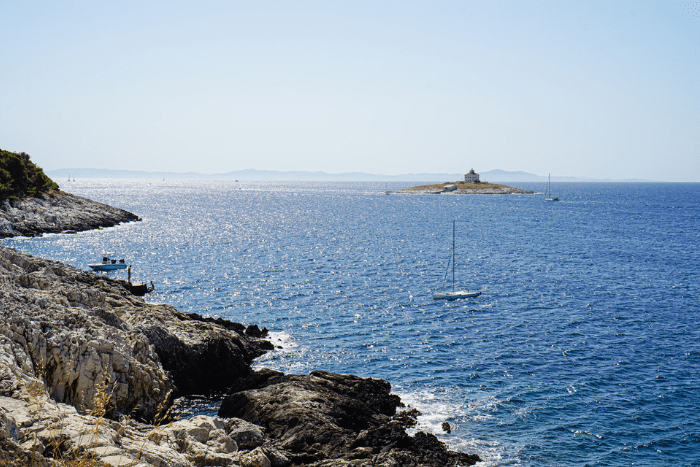
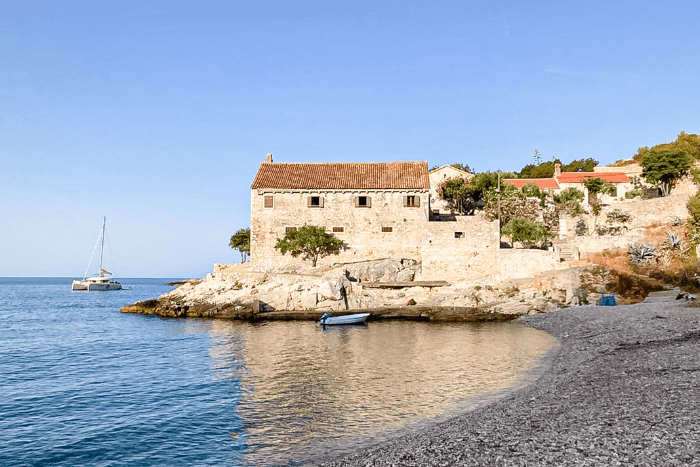
- Explore Stari Grad. This is a lovely old town on the northern side of the island. It’s actually one of the oldest towns in Europe. It’s much calmer than the center of Hvar but also has beautiful shops and restaurants. Make sure to check out Za Pod Zub for some yummy snacks or souvenirs.
- Discover the abandoned villages. Hvar is known for having a number of abandoned villages that are certainly worth exploring. We loved Malo Grablje, in part because of the lovely Stori Komin restaurant and Velo Grablje is about 40 minutes away. If you’re up for it, you can keep hiking for another hour until you reach the beautiful Hvar Lavender Fields.
- Take a ferry to Bol. We chose to take a ferry to Bol one day, mainly to visit the Stina Winery. A waiter in Hvar had told us all about it, so we had to check it out. Stina means stone in Croatia and Bol is famous for the Brač white stone. As a result, the wine cellar is uniquely designed using that stone. But, the coolest part is the labels. They are completely white, made from a paper that resembles white stone, with the hopes that people will get inspired to draw their own labels.


Where to Eat & Drink
- Zlatan Otok (nice restaurant on the water, offering tastings from the Zlatan Otok winery)
- Konoba Stori Komin (the most memorable meal of our trip, located in the abandoned village of Malo Grablje, with incredible views and the most peaceful atmosphere. Make sure to call ahead and order the octopus under the bell)
- Konoba Maestro (delicious seafood, in a small alley in between old buildings)
- Konoba Kokot (family-run restaurant known for its meat dishes, especially lamb)
- Oaza in Milna (fresh seafood restaurant, right on the beach)
- Wine Bar Prsuta 3 (wonderful selection of local wines, with a vibrant atmosphere)
- Kava37 (a small spot with yummy coffee and pastries)
- Vinarija Braća Plančić (incredibly friendly winery with delicious wines)
- Vina Tomić (beautiful winery and cellar)
Day 5: Korčula

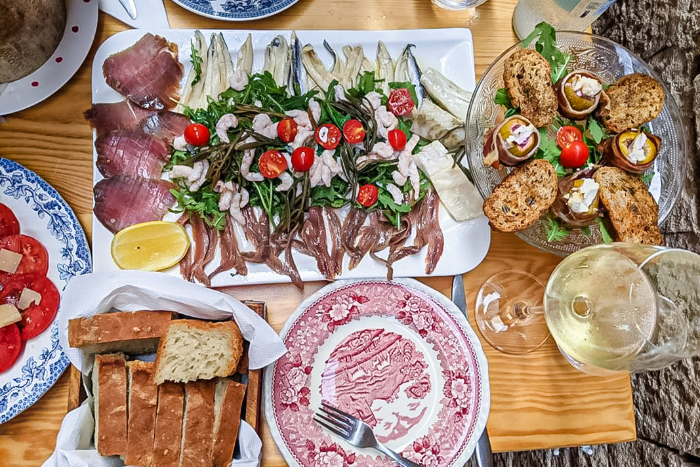
After Hvar, we decided to go to the island of Korčula. We didn’t want to bring our car to Korčula but wanted to continue our Croatia road trip, so we drove to Sućuraj, in the eastern part of Hvar, and took the 30-minute ferry to Drvenic, back on the mainland. From there, we drove about an hour and a half to the town of Orebić in the Pelješac Peninsula. We left our car there for the night and took the 15-minute ferry to Korčula.
The island of Korčula is smaller than Hvar, and not surprisingly, is known for its stunning beaches, clear waters, lush green forests, and picturesque medieval towns. The island’s main town is often compared to Venice due to its winding streets and impressive architecture.
But one of the most special parts about this island (and our biggest selling point) is its crisp white wine, made from the unique Grk grape, which grows right behind the Vela Przina Beach.
There’s certainly so much more to do in Korčula than you can in one day, so if you have the time, certainly stay longer.
Where to Stay
- Aminess Korcula Heritage Hotel (the oldest hotel on the island, in the heart of Korčula)
- Loft in Ismaelli Palace Korcula (cozy apartment in the old city center)
- Korcula Hill (beautiful property with a pool and beach access)
- ECO Aparthotel The Dreamers’s Club (incredible property in Lumbarda with magical sunsets)
- Apartments Lumbarda Beach (spacious apartment in Lumbarda, right on the water and with a lovely terrace)
- Boutique Rooms Kastel Ismaeli (spacious and modern rooms in Vela Luka)
- Pine Tree Apartment Zanetic (secluded villa in Blato, with direct access to the sea)
What to Do
- Get lost in the Old Town of Korčula. The town is famous for its well-preserved medieval architecture, narrow streets, and stunning views of the sea. It’s the perfect place to walk around without looking at Google Maps and explore hidden alleyways. Make sure to walk along the Old Town’s defensive walls, which are still intact today.
- Visit Marco Polo’s house. Many believe that Marco Polo was born in Korčula, and people can explore the Marco Polo Museum to learn more about his life and travels.
- Catch some rays on the beach. Croatian beaches are usually pebbled, but if you take a 15-minute bus ride to the village of Lumbarda, you’ll spot two lovely sandy beaches (Vela Przina and Bilin Zal). Pupnatska Luka is another great option.
- Go wine tasting. The island of Korčula is known for its crisp white wine, made from the unique Grk grape, and there are many great wineries worth exploring. We love the Zure and Bire wineries in Lumbarda, but there are plenty of options throughout the island.

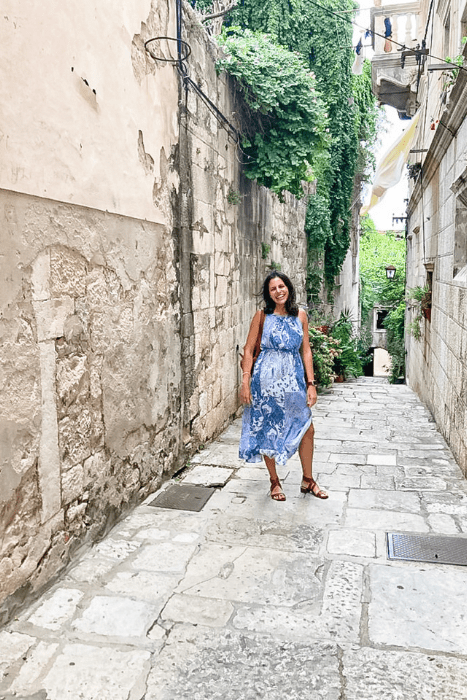
Where to Eat & Drink
- Lole Wine & Tapas Bar (small spot but delicious fish platter)
- LD Restaurant (Michelin-star restaurant right on the water)
- Zure Winery & Restaurant (traditional dalmatian cuisine, paired nicely with their wines)
- Konoba Maha (traditional cuisine with a lovely atmosphere)
- Bokar Wine Bar (excellent wine and friendly staff)
- Cukarin (beautiful local treats)
- Bire Winery (beautiful vineyard serving local Grk white wine)
Day 6: Pelješac Peninsula
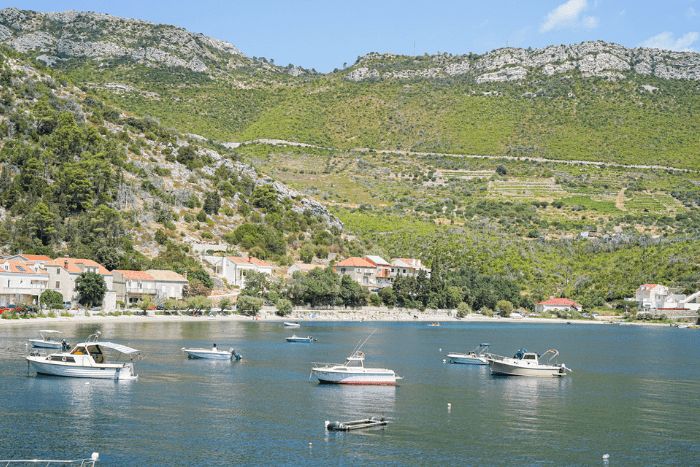
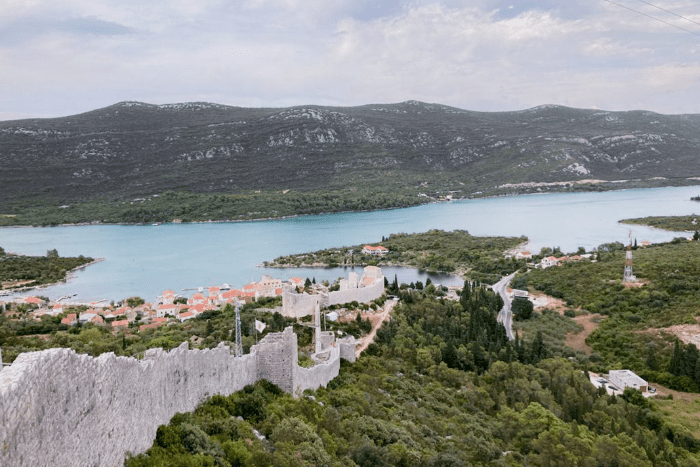
After our day in Korčula, we took the 15-minute ferry ride to Orebić to pick up our car and continue our Croatia road trip along the Pelješac Peninsula. We had a pretty detailed itinerary, so will share it exactly as we did it, but of course, you can add or skip spots to make it your own.
Stop 1: Matuško Winery
The vineyard is only a 20-minute drive east of Orebić and is certainly worth the visit. We did a brief tour of the cellars, where we learned everything about the history of the region and the winery, and some unique facts about their wines, including a red that they keep for 6 months underground in clay barrels.
It’s also a nice area to do a tasting afterward, either in their bar inside or outside, overlooking the vineyard. Though they’re known for their reds, we would also recommend trying their sparkling wine. We quite enjoyed its fresh and crispy taste on a warm day.


Stop 2: Vitaceae
They started us out with some local liquor and after some nice appetizers, we chose the seafood platter – and wow. If you order it, the chef will actually take you back so you can see the outdoor, stone grill, and the food being prepared. The plate is based on whatever they caught that morning and cooked simply with oil and salt. We cannot wait to go back.
On your drive from Matuško to Vitaceae, make sure to take the route that takes you through the Dingač Tunnel. The tunnel is narrow and short and allows you to go directly from the mountains to the coast, providing some amazing views, without having to use the bypass.


Stop 3: Grgić Winery
The winery was created in the 1990s by a famous Napa Valley winemaker who was born in Croatia, with the purpose of concentrating on “Croatia’s very best varietals”. The wine is delicious, but the part of this winery is the views. It has a lovely outdoor terrace, overlooking the Mediterranean ocean and the harbor.

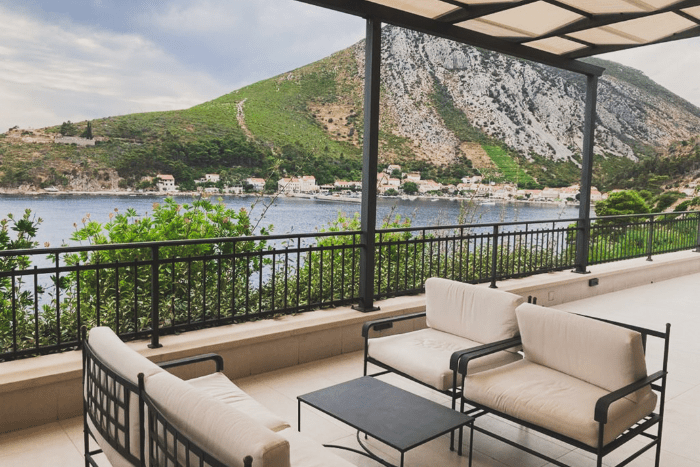
Stop 4: The Town of Ston
About a 30-minute drive away from Grgić is the town of Ston, located on the narrow strip of land that connects the peninsula to the mainland. The town is famous for its historic defensive walls, which were built in the 14th and 15th centuries to protect the town and its salt pans from invaders. The walls are much longer than the famous ones of Dubrovnik, making them the longest defensive structure in Europe, and sometimes even referred to as the “European Walls of China”.
The tickets to access the walls are 10 Euros per person, but certainly worth it. The Ston city walls consist of the main wall and three forts, as well as 41 towers, seven bastions, and four pre-walls. The views from the top and the different points throughout are incredible, looking out both into the city and the ocean. It took us about an hour to go from one end to the other (from Ston to Mali Ston).
Just note that you will need to walk back to Ston, either on the street or through the walls, to get back to your car. Before heading back to your car, make sure to stop in Kapetanova Kuća for some incredible oysters. We were still quite stuffed from our lunch, but if you’re hungry, also treat yourself to their famous mussels.
Though we didn’t get to explore them, Ston is also known for its salt pans, which have been in operation for over 4,000 years. The salt pans are still in use today, and visitors can take a tour of the pans and learn about the traditional methods used to produce salt.
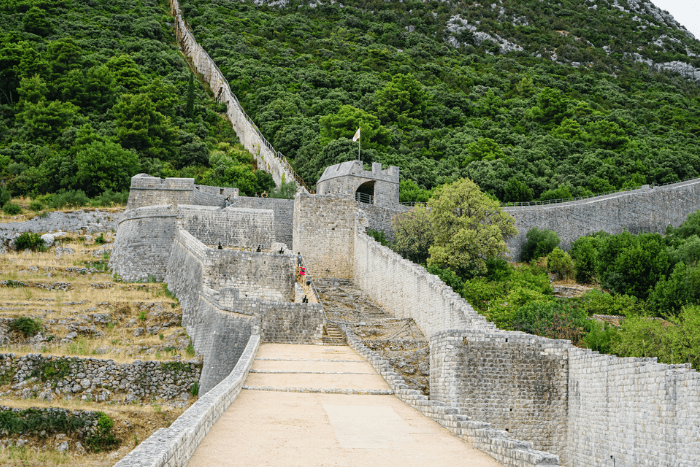
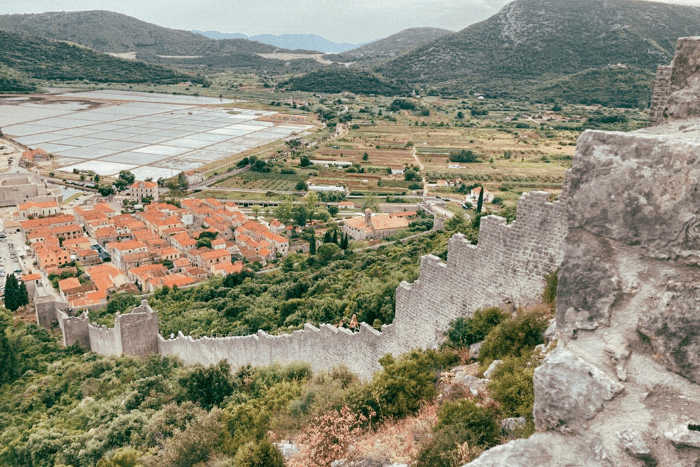
Where to Stay
Day 7-8: Dubrovnik
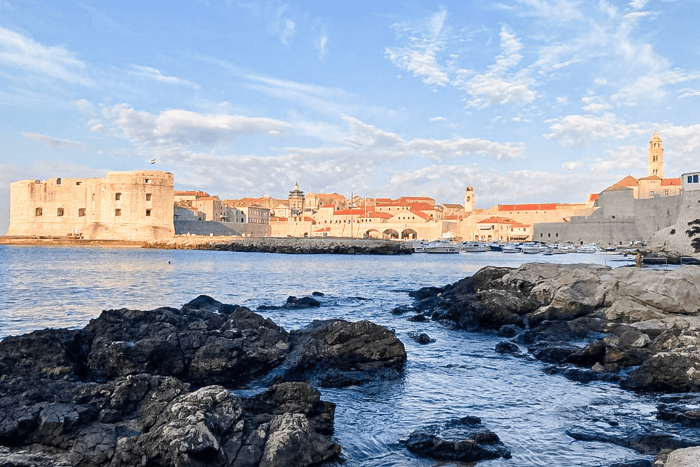
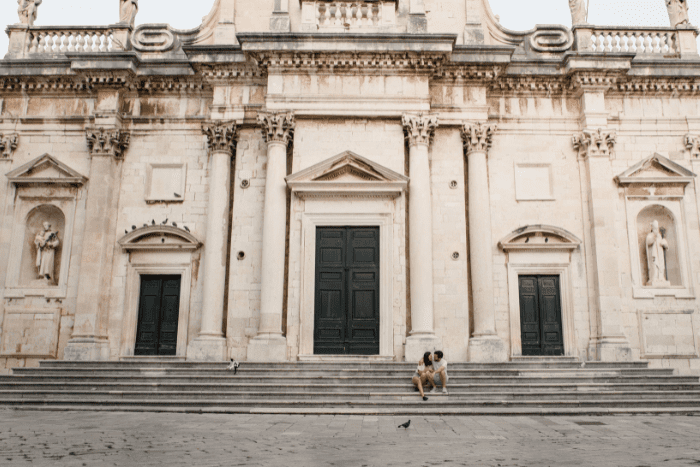
We chose to end our Croatia road trip in the beautiful city of Dubrovnik. The city has become increasingly more popular since the Game of Thrones series, as it was the main filming location for King’s Landing. It’s an absolutely stunning place, with incredible architecture, well-preserved historical landmarks, and breathtaking natural beauty.
The city is often referred to as the “Pearl of the Adriatic” due to its location on the waters of the Adriatic Sea and its rich cultural heritage.
One of the most impressive features of Dubrovnik is its well-preserved Old Town, which is surrounded by massive stone walls that date back to the 16th century. This area is a UNESCO World Heritage site and is home to some of the city’s most impressive landmarks, including the Sponza Palace, St. Blaise Church, and Onofrio’s Fountain.
Where to Stay
- Villa 5bd (modern rooms, beautifully decorated, in the heart of the Old City)
- Boutique Hotel Stari Grad (charming property, with incredible views from the rooftop)
- Apartments Luna (comfortable apartments, with a wonderful terrace overlooking the City Walls)
- Apartments Villa Ankora (exceptional views, just a 10-minute walk away from the Old City)
- Dubrovnik Finest Apartments (cozy and well-equipped studio apartments, steps away from the Old City)
- Veranda Rooms (simple rooms in a quiet, yet centric location)
- Hotel Bellevue Dubrovnik (lovely hotel with private beach, 15-minute walk away from the Old City)
- Villa Orabelle (stunning boutique hotel with a pool, gorgeous views, and a yummy breakfast, a 30-minute walk away from the Old City)
What to Do
- Explore the city walls. Constructed during the 13th and 14th centuries and surrounding the historic Old Town, the city walls have to be Dubrovnik’s most iconic landmark. Though the price to visit them is not cheap (35 Euros including access to the Lovrijenac Fort), it’s essentially a must. You’ll get to admire stunning views of the city and the architecture from a completely different perspective and get a sense of the impressive defensive capabilities of the walls. If you’re visiting in the summer, we highly recommend going early to avoid the crowds and the sun, since there’s almost no shade.
- Hike to the Lovrijenac Fort. Getting up there is a bit of a hike, but the views are incredible. It’s located on the western side of the Old Town, outside the city walls a rocky cliff. For Game of Thrones fans, Fort Lovrijenac doubles as the Red Keep in King’s Landing. Note that your ticket for the city walls includes an entrance into this fort, but not vice versa.
- Do your own GOT tour. Of course, there are plenty of official GOT tours you can take. However, if you’re like us, and don’t necessarily want to pay for one, we recommend finding a blog online and following along. We Seek Travel does a great job laying out the filming locations for you to embark on your own self-guided tour.


- Take a boat to Lokrum Island. This is the perfect place to relax and escape the crowds, just a short boat ride away from Dubrovnik. Again, for GOT fans, this is the place where they filmed Qarth. You can walk around the island and explore the Monastery and an extremely salty area called the “Dead Sea”. And then find a spot in one of the large rocks and enjoy the views. These were our favorite waters of the trip.
- Hire a photographer for your own mini photo shoot. Mike was not a huge fan of this idea initially, but even he was surprised. We found Katica on Instagram and cannot recommend her enough. She was incredibly professional and made us feel comfortable throughout the whole shoot. And the photos were absolutely incredible – and nothing we could’ve gotten on our own or by borrowing a friend. Just make sure to do this early in the morning (we went at 6am) to avoid the crowds.
- Go kayaking around Dubrovnik. This is the one thing we didn’t get to do that we really wanted. We simply ran out of time, but we can only imagine that the views of the city from the water have to be absolutely breathtaking.
- Shop at Life According to Kawa. This is a really cute boutique, outside the walls of the city, selling wonderful things made in Croatia, from food and spices to jewelry and clothes.
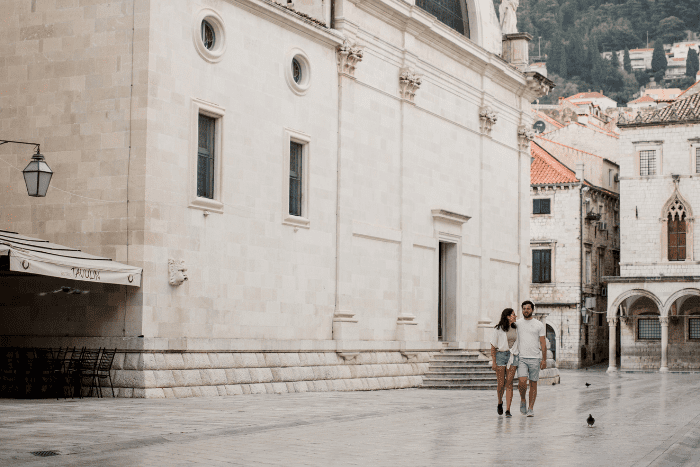
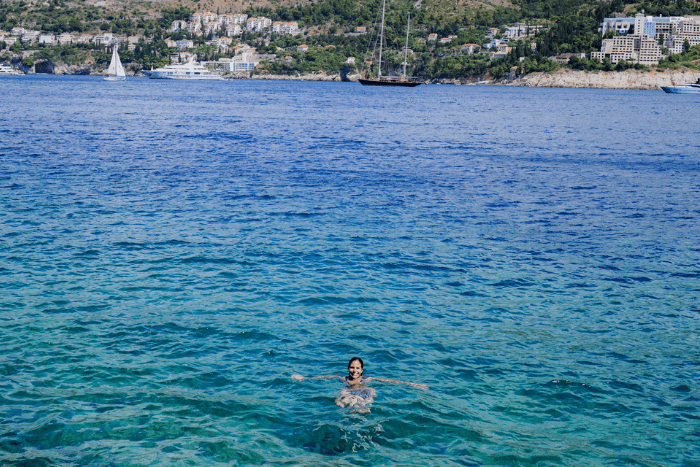
Where to Eat & Drink
- Proto (delicious fish and scallops in the heart of the old town with wonderful service)
- Gradska Kavana Arsenal (the most spectacular views of the walls and crystal clear waters)
- Azur (total mix of flavors, resembling Asian-Mediterranean fusion)
- Barba (yummy seafood sandwiches, perfect for a quick lunch)
- Take Away Dubrovnik (good burgers and ćevapi, perfect for a late-night snack)
- D’Vino Wine Bar (incredible selection of wines, 60+ by the glass)
- Buza Bar (small hole in the wall, but in the best location, directly on the cliffs, right next to the water. Great spot to go to at sunset)
- Glam Beer Therapy (great beer selection and yummy espresso martinis)
- Mr. Goodlife Bar (nice gin bar with live music, outside the city walls)
- Cogito Coffee (probably the best coffee in Dubrovnik)
Save for Later? Pin It!
